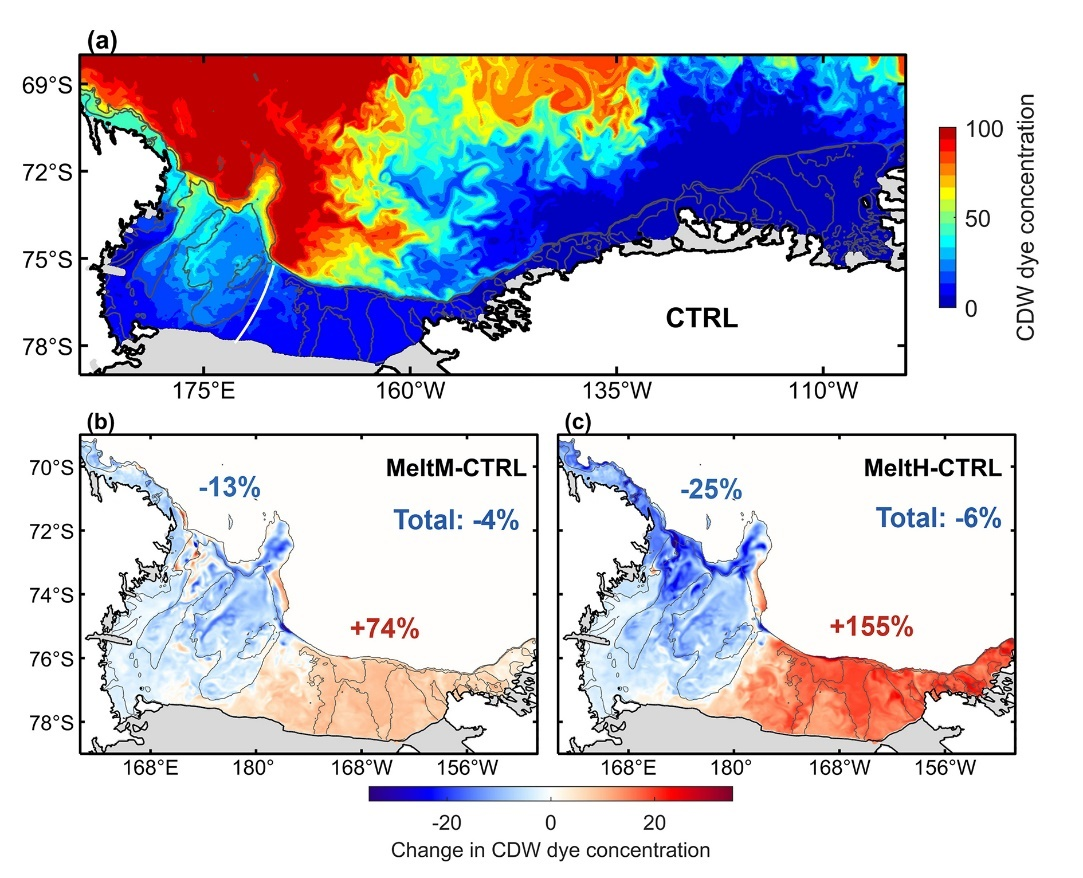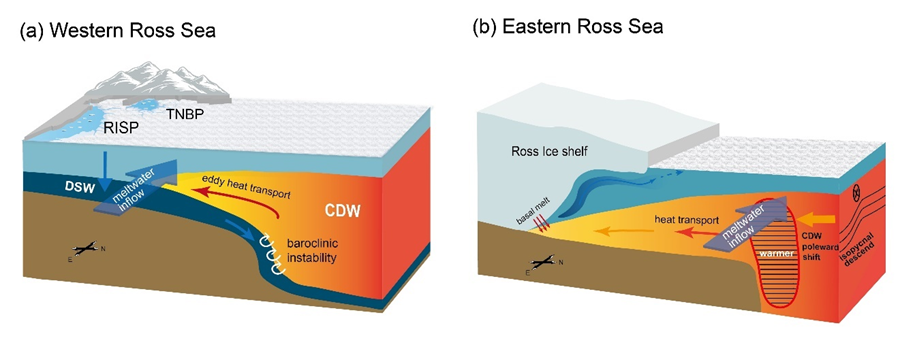On 24 July 2024, Chuan Xie, the PhD student of School of Oceanography, Shanghai Jiao Tong University (SJTU-SOO), published a research article titled “The Response of Ross Sea Shelf Water Properties to Enhanced Amundsen Sea Ice Shelf Melting” as the first author in Journal of Geophysical Research: Oceans. The paper was completed by Chuan Xie (first author), Associate Professor Zhaoru Zhang (corresponding author) Dr. Yuanjie Chen, Dr. Chuning Wang and Professor Meng Zhou from SJTU-SOO.

Ice shelves in the Amundsen Sea have experienced the most rapid melting in the Antarctic and are expected to accelerate throughout this century under climate warming. In this study, a high-resolution ocean-sea ice-ice shelf model (Figure 1) is employed to conduct sensitivity experiments to explore the effects of increasing melt rates of the Amundsen Sea ice shelves on hydrography, sea ice and ice shelf in the Ross Sea. The results indicate that the substantial inflow of meltwater significantly freshens the Ross Sea, inhibiting the formation and export of the Dense Shelf Water, the volume of which is reduced by 19%–33% on the shelf. Circumpolar Deep Water (CDW) tracer experiments indicate that under the scenario of increased meltwater, there are significant opposing changes in the volume of CDW intrusion into the eastern and western Ross Sea (Figure 2). This lead to different responses of water temperature on the eastern and Ross Sea shelves. The freshening of the western Ross Sea weakens the mesoscale eddy activities that are efficient in carrying warm CDW onto the shelf (Figure 3a), leading to an average temperature decrease of 0.02–0.08°C. Conversely, in the eastern Ross Sea, there is a marked warming outside the shelf under increased meltwater, which results from zonal pressure gradients created by the meltwater transport and distribution (Figure 3b). This consequently causes stronger on-shelf heat transport and warming of 0.12–0.22°C on the eastern Ross Sea shelf. The narrow shelf in the eastern Ross Sea allows the warm water to reach the Ross Ice Shelf (RIS) front, resulting in an about 6%–9% increase in the RIS melting. These results suggest a possible mechanism for acceleration in the RIS melting in the future that is associated with enhanced meltwater inflow from the Amundsen Sea.
Figure 1. Domain and grid of the coupled ocean-sea ice-ice shelf model over the Ross Sea and the Amundsen Sea. The inset shows the location of model domain in the Southern Ocean. The color indicates the bathymetry, and the gray areas indicate ice shelves.
Figure 2. (a) The Circumpolar Deep Water (CDW) dye concentrations on the model level 16 (mid-depth) for 2 years after the dye is released in the CTRL simulation. The initial concentration of CDW dye is 100. Differences in CDW dye concentrations on the Ross Sea continental shelf (b) between the Medium Melt scenario experiment (MeltM) and CTRL and (c) between the High Melt scenario experiment (MeltH) and CTRL. The white line in panel (a) represents the boundary between the eastern and the western Ross Sea shelf.

Figure 3. Schematic diagrams illustrating the intrusion of Circumpolar Deep Water (CDW) onto the shelf and the resulting changes in heat transports in (a) the western Ross Sea and (b) the eastern Ross Sea under accelerated ice shelf melting in the Amundsen Sea.
This research is funded by the Key Research & Development Program of the Ministry of Science and Technology of China (2022YFC2807601), the National Natural Science Foundation of China (41941008), the Shanghai Science and Technology Committee (21QA1404300), the Shanghai Pilot Program for Basic Research of Shanghai Jiao Tong University (TQ1400201), and the Shenlan Program funded by Shanghai Jiao Tong University (SL2020MS021).
Link to the article:
https://doi.org/10.1029/2024JC020919
Contributed by Research Group of Prof. Zhaoru Zhang
